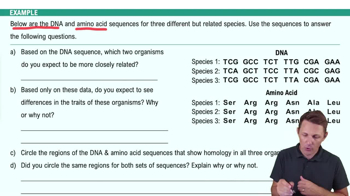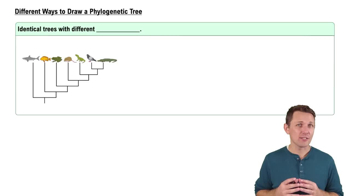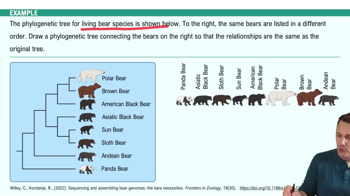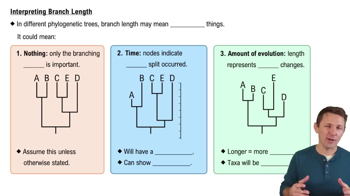Table of contents
- 1. Introduction to Biology2h 40m
- 2. Chemistry3h 40m
- 3. Water1h 26m
- 4. Biomolecules2h 23m
- 5. Cell Components2h 26m
- 6. The Membrane2h 31m
- 7. Energy and Metabolism2h 0m
- 8. Respiration2h 40m
- 9. Photosynthesis2h 49m
- 10. Cell Signaling59m
- 11. Cell Division2h 47m
- 12. Meiosis2h 0m
- 13. Mendelian Genetics4h 41m
- Introduction to Mendel's Experiments7m
- Genotype vs. Phenotype17m
- Punnett Squares13m
- Mendel's Experiments26m
- Mendel's Laws18m
- Monohybrid Crosses16m
- Test Crosses14m
- Dihybrid Crosses20m
- Punnett Square Probability26m
- Incomplete Dominance vs. Codominance20m
- Epistasis7m
- Non-Mendelian Genetics12m
- Pedigrees6m
- Autosomal Inheritance21m
- Sex-Linked Inheritance43m
- X-Inactivation9m
- 14. DNA Synthesis2h 27m
- 15. Gene Expression3h 20m
- 16. Regulation of Expression3h 31m
- Introduction to Regulation of Gene Expression13m
- Prokaryotic Gene Regulation via Operons27m
- The Lac Operon21m
- Glucose's Impact on Lac Operon25m
- The Trp Operon20m
- Review of the Lac Operon & Trp Operon11m
- Introduction to Eukaryotic Gene Regulation9m
- Eukaryotic Chromatin Modifications16m
- Eukaryotic Transcriptional Control22m
- Eukaryotic Post-Transcriptional Regulation28m
- Eukaryotic Post-Translational Regulation13m
- 17. Viruses37m
- 18. Biotechnology2h 58m
- 19. Genomics17m
- 20. Development1h 5m
- 21. Evolution3h 1m
- 22. Evolution of Populations3h 52m
- 23. Speciation1h 37m
- 24. History of Life on Earth2h 6m
- 25. Phylogeny2h 31m
- 26. Prokaryotes4h 59m
- 27. Protists1h 12m
- 28. Plants1h 22m
- 29. Fungi36m
- 30. Overview of Animals34m
- 31. Invertebrates1h 2m
- 32. Vertebrates50m
- 33. Plant Anatomy1h 3m
- 34. Vascular Plant Transport2m
- 35. Soil37m
- 36. Plant Reproduction47m
- 37. Plant Sensation and Response1h 9m
- 38. Animal Form and Function1h 19m
- 39. Digestive System10m
- 40. Circulatory System1h 57m
- 41. Immune System1h 12m
- 42. Osmoregulation and Excretion50m
- 43. Endocrine System4m
- 44. Animal Reproduction2m
- 45. Nervous System55m
- 46. Sensory Systems46m
- 47. Muscle Systems23m
- 48. Ecology3h 11m
- Introduction to Ecology20m
- Biogeography14m
- Earth's Climate Patterns50m
- Introduction to Terrestrial Biomes10m
- Terrestrial Biomes: Near Equator13m
- Terrestrial Biomes: Temperate Regions10m
- Terrestrial Biomes: Northern Regions15m
- Introduction to Aquatic Biomes27m
- Freshwater Aquatic Biomes14m
- Marine Aquatic Biomes13m
- 49. Animal Behavior28m
- 50. Population Ecology3h 41m
- Introduction to Population Ecology28m
- Population Sampling Methods23m
- Life History12m
- Population Demography17m
- Factors Limiting Population Growth14m
- Introduction to Population Growth Models22m
- Linear Population Growth6m
- Exponential Population Growth29m
- Logistic Population Growth32m
- r/K Selection10m
- The Human Population22m
- 51. Community Ecology2h 46m
- Introduction to Community Ecology2m
- Introduction to Community Interactions9m
- Community Interactions: Competition (-/-)38m
- Community Interactions: Exploitation (+/-)23m
- Community Interactions: Mutualism (+/+) & Commensalism (+/0)9m
- Community Structure35m
- Community Dynamics26m
- Geographic Impact on Communities21m
- 52. Ecosystems2h 36m
- 53. Conservation Biology24m
25. Phylogeny
Phylogeny
Problem 3a
Textbook Question
Textbook QuestionHow are hypotheses about the evolutionary relationships among living organisms tested?
 Verified step by step guidance
Verified step by step guidance1
Identify the organisms or groups of organisms that you want to study and determine the characteristics (morphological, genetic, behavioral) that will be analyzed to infer evolutionary relationships.
Formulate a hypothesis about the evolutionary relationships among the chosen organisms. This hypothesis should be based on existing knowledge, observations, or preliminary data.
Collect data on the chosen characteristics from the organisms being studied. This can involve field studies, laboratory experiments, or analysis of existing databases.
Analyze the collected data using phylogenetic methods. These methods can include constructing phylogenetic trees based on similarities and differences in the genetic or morphological data to visualize the hypothesized evolutionary relationships.
Test the robustness of the phylogenetic tree by comparing it with trees generated from different datasets or by using different phylogenetic methods. Revise the hypothesis if necessary based on the outcomes and seek peer review and publication to validate the findings.
Recommended similar problem, with video answer:
 Verified Solution
Verified SolutionThis video solution was recommended by our tutors as helpful for the problem above
Video duration:
1mPlay a video:
Was this helpful?
Key Concepts
Here are the essential concepts you must grasp in order to answer the question correctly.
Hypothesis Testing in Evolutionary Biology
In evolutionary biology, hypotheses about relationships among organisms are tested through various methods, including comparative anatomy, molecular biology, and phylogenetics. Researchers formulate hypotheses based on observed traits and genetic data, which are then evaluated using statistical models to determine the likelihood of different evolutionary scenarios.
Recommended video:
Guided course

Test Crosses
Phylogenetics
Phylogenetics is the study of evolutionary relationships among biological entities, often represented in tree-like diagrams called phylogenetic trees. These trees illustrate how species are related through common ancestry, and they are constructed using data from morphological characteristics and genetic sequences, allowing scientists to visualize and test hypotheses about evolutionary pathways.
Recommended video:

Building Phylogenetic Trees Example 2
Molecular Evidence
Molecular evidence, particularly DNA and protein sequences, plays a crucial role in testing evolutionary hypotheses. By comparing genetic material across different organisms, scientists can identify similarities and differences that indicate evolutionary relationships. This molecular approach often provides more precise insights than morphological comparisons alone, leading to a better understanding of how species have evolved over time.
Recommended video:

Evidence of Evolution Example 2

 7:10m
7:10mWatch next
Master Reading a Phylogenetic Tree with a bite sized video explanation from Bruce Bryan
Start learningRelated Videos
Related Practice





















